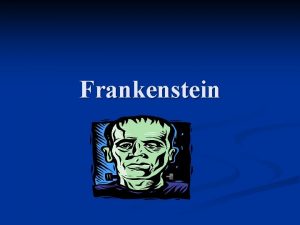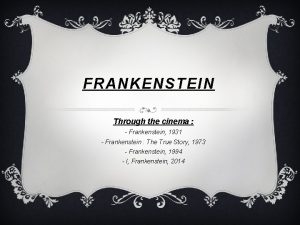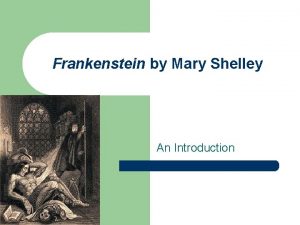Introduction to Frankenstein Frankenstein is the story of







- Slides: 7

Introduction to Frankenstein

Frankenstein is the story of… • Victor Frankenstein – Swiss scientist • Creature is produced out of old body parts – Human-like monster • Ruins Victor’s life

Structure • Form: Epistolary novel – Story within a story, series of documents • Usually letters • Adds elements of realism, mimics real life » Letters in Frankenstein document correspondence between Captain Robert Walton and his sister, Margaret Walton Saville

Language of Frankenstein • Side notes through the text in parenthesis (side comment from narrator) • Diction makes images through story more vivid and dramatic – Adds to suspense – Reminder that story is told orally • Lengthy descriptions – can be dry, but are important – Intertwined with action • Foreshadowing and paranoia – Emotional outburst after significant events • Emotional connection to characters allows for personal connection between author and reader

Gothic and Romantic Literature • Elements of horror and romance – Extension of romantic elements (nature, etc. ) • An atmosphere of mystery and suspense – A threatening feeling, a fear enhanced by the unknown. Plot built around a mystery: disappearance, etc. • Omens, portents, visions – A character has a disturbing dream, vision or some phenomenon may be seen as an impending event • Supernatural or otherwise inexplicable events – Dramatic, amazing events occur, such as ghosts or giants walking, or inanimate objects • The metonymy of gloom and horror – Metonymy is a subtype of metaphor, in which something (like rain) is used to stand for something else (like sorrow) http: //www. virtualsalt. com/gothic. htm

Odds and Ends • Early example of science fiction – Largely influenced many science fiction novels of today • Author, Mary Shelley – Wrote the book when she was 19 – Recent events of industrial revolution • transition to new manufacturing processes » Many people nervous about new scientific and technological possibilities » Science vs. God became big issue

It’s time to write… • Think about new scientific and technological advancements and possibilities we’re currently working with or considering. (brainstorm as a class) – Do these scientific/technological advancements concern you? Why or why not? • What are the possibilities of violating the ethical limits with the application of technological discovery and unleashing an uncontrollable evil to roam within this world? » Stem cell debate? *Dolly the sheep: female sheep – domestic, cloned from adult somatic cell (biological cell) using the process of nuclear transfer(for of cloning – remove DNA, inject, so on and so forth.













